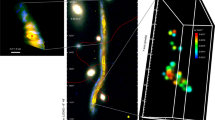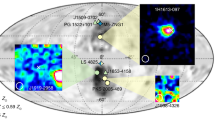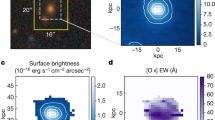Abstract
Spiral galaxies must acquire gas to maintain their observed level of star formation beyond the next few billion years1. A source of this material may be the gas that resides between galaxies, but our understanding of the state and distribution of this gas is incomplete2. Radio observations3 of the Local Group of galaxies have revealed hydrogen gas extending from the disk of the galaxy M31 at least halfway to M33. This feature has been interpreted to be the neutral component of a condensing intergalactic filament4, which would be able to fuel star formation in M31 and M33, but simulations suggest that such a feature could also result from an interaction between both galaxies within the past few billion years (ref. 5). Here we report radio observations showing that about 50 per cent of this gas is composed of clouds, with the rest distributed in an extended, diffuse component. The clouds have velocities comparable to those of M31 and M33, and have properties suggesting that they are unrelated to other Local Group objects. We conclude that the clouds are likely to be transient condensations of gas embedded in an intergalactic filament and are therefore a potential source of fuel for future star formation in M31 and M33.
This is a preview of subscription content, access via your institution
Access options
Subscribe to this journal
Receive 51 print issues and online access
$199.00 per year
only $3.90 per issue
Buy this article
- Purchase on Springer Link
- Instant access to full article PDF
Prices may be subject to local taxes which are calculated during checkout



Similar content being viewed by others
References
Leroy, A. K. et al. The star formation efficiency in nearby galaxies: measuring where gas forms stars effectively. Astron. J. 136, 2782–2845 (2008)
Shull, J. M., Smith, B. D. & Danforth, C. W. The baryon census in a multiphase intergalactic medium: 30% of the baryons may still be missing. Astrophys. J. 759, 23–37 (2012)
Braun, R. & Thilker, D. A. The WSRT wide-field H I survey II. Local Group features. Astron. Astrophys. 417, 421–435 (2004)
Davé, R. et al. Baryons in the warm-hot intergalactic medium. Astrophys. J. 552, 473–483 (2001)
Bekki, K. Formation of a giant HI bridge between M31 and M33 from their tidal interaction. Mon. Not. R. Astron. Soc. 390, L24–L28 (2008)
Lockman, F. J., Free, N. L. & Shields, J. C. The neutral hydrogen bridge between M31 and M33. Astron. J. 144, 52–58 (2012)
Popping, A., Davé, R., Braun, R. & Oppenheimer, B. D. The simulated H I sky at low redshift. Astron. Astrophys. 504, 15–32 (2009)
Maloney, P. Sharp edges to neutral hydrogen disks in galaxies and the extragalactic radiation field. Astrophys. J. 414, 41–56 (1993)
Ibata, R. et al. The haunted halos of Andromeda and Triangulum: a panorama of galaxy formation in action. Astrophys. J. 671, 1591–1623 (2007)
McConnachie, A. W. et al. The remnants of galaxy formation from a panoramic survey of the region around M31. Nature 461, 66–69 (2009)
Lewis, G. F. et al. PAndAS in the mist: the stellar and gaseous mass within the halos of M31 and M33. Astrophys. J. 763, 4–13 (2013)
Tully, R. B. & Fisher, J. R. A new method of determining distances to galaxies. Astron. Astrophys. 54, 661–673 (1977)
McGaugh, S. S., Schombert, J. M., Bothun, G. D. & de Blok, W. J. G. The baryonic Tully-Fisher relation. Astrophys. J. 533, L99–L102 (2000)
Fukugita, M. & Peebles, P. J. E. The cosmic energy inventory. Astrophys. J. 616, 643–668 (2004)
Gentile, G. et al. Tidal dwarf galaxies as a test of fundamental physics. Astron. Astrophys. 472, L25–L28 (2007)
Maller, A. H. & Bullock, J. S. Multiphase galaxy formation: high-velocity clouds and the missing baryon problem. Mon. Not. R. Astron. Soc. 355, 694–712 (2004)
Fernández, X., Joung, M. R. & Putman, M. E. The origin and distribution of cold gas in the halo of a Milky-Way-mass galaxy. Astrophys. J. 749, 181–192 (2012)
Chynoweth, K. et al. Neutral hydrogen clouds in the M81/M82 group. Astron. J. 135, 1983–1992 (2008)
Boothroyd, A. I. et al. Accurate galactic 21-cm H I measurements with the NRAO Green Bank Telescope. Astron. Astrophys. 536, A81 (2011)
Thilker, D. A. et al. On the continuing formation of the Andromeda galaxy: detection of H I clouds in the M31 halo. Astrophys. J. 601, L39–L42 (2004)
Grossi, M. et al. H I clouds in the proximity of M33. Astron. Astrophys. 487, 161–175 (2008)
Westmeier, T., Brüns, C. & Kerp, J. Relics of structure formation: extra-planar gas and high velocity clouds around the Andromeda Galaxy. Mon. Not. R. Astron. Soc. 390, 1691–1709 (2008)
Putman, M. E. et al. The disruption and fueling of M33. Astrophys. J. 703, 1486–1501 (2009)
McGaugh, S. S. & Wolf, J. Local Group dwarf spheroidals: correlated deviations from the baryonic Tully-Fisher relation. Astrophys. J. 722, 248–261 (2010)
Tollerud, E. J. The SPLASH survey: spectroscopy of 15 M31 dwarf spheroidal satellite galaxies. Astrophys. J. 752, 45–73 (2012)
McGaugh, S. S. The baryonic Tully-Fisher relation of gas-rich galaxies as a test of ΛCDM and MOND. Astron. J. 143, 40–54 (2012)
Acknowledgements
D.J.P. is an Adjunct Assistant Astronomer at the National Radio Astronomy Observatory; F.J.L. is an Adjunct Professor in the Department of Physics, West Virginia University. S.A.W. acknowledges the student observing support (GSSP11-012) provided by the NRAO for this project. The NRAO is a facility of the NSF operated under cooperative agreement by Associated Universities, Inc. D.J.P. acknowledges support from NSF CAREER grant AST-1149491. S.S.M. acknowledges support in part by NSF grant AST-0908370.
Author information
Authors and Affiliations
Contributions
All authors assisted in the development and writing of this work. S.A.W. is the Principal Investigator, and was responsible for data collection, processing and analysis. D.J.P. and F.J.L. assisted in the experimental design, data collection and analysis. S.S.M. provided the techniques of estimating the baryonic masses. E.J.S. provided necessary insights on potential interactions with M31 and ways of estimating circular rotation speeds. All authors aided in the interpretation of the results and provided comments for revisions to this work.
Corresponding author
Ethics declarations
Competing interests
The authors declare no competing financial interests.
Supplementary information
Supplementary Figure
This file contains Supplementary Figure 1, which presents channels maps, as a single figure, to allow the reader to see the HI clouds' evolution through the data cube. The text points out the velocity ranges of each HI cloud and points out specific features, when apparent. (PDF 1495 kb)
Rights and permissions
About this article
Cite this article
Wolfe, S., Pisano, D., Lockman, F. et al. Discrete clouds of neutral gas between the galaxies M31 and M33. Nature 497, 224–226 (2013). https://doi.org/10.1038/nature12082
Received:
Accepted:
Published:
Issue Date:
DOI: https://doi.org/10.1038/nature12082
This article is cited by
-
The cosmic web in focus
Nature (2013)
Comments
By submitting a comment you agree to abide by our Terms and Community Guidelines. If you find something abusive or that does not comply with our terms or guidelines please flag it as inappropriate.



